Identifying Human-Induced Spatial Differences of Soil Erosion Change in a Hilly Red Soil Region of Southern China
Abstract
:1. Introduction
2. Study Area and Materials
2.1. Study Area
2.2. Materials
3. Methods
3.1. RUSLE Model
3.2. Gravity-Center Model of Soil Erosion
3.3. Gravity-Center’s Migration VECTOR model
3.4. Contribution Rate Decomposition Model
4. Results
4.1. Regional SE Change
4.2. Spatial Pattern of Regional SE Change
4.3. Spatial Differences of SE Change
4.3.1. Spatial Differences of SE Change under Natural and Human Influence
4.3.2. Human-Induced Spatial Differences of SE Change
5. Discussion
6. Conclusions
Author Contributions
Funding
Conflicts of Interest
References
- He, X.; Jie, Z.; Zhang, X.; Tang, K. Soil erosion response to climatic change and human activity during the Quaternary on the Loess Plateau, China. Reg. Environ. Chang. 2006, 6, 62–70. [Google Scholar] [CrossRef]
- Xiao, L.; Yang, X.; Chen, S.; Cai, H. An assessment of erosivity distribution and its influence on the effectiveness of land use conversion for reducing soil erosion in Jiangxi, China. Catena 2015, 125, 50–60. [Google Scholar] [CrossRef]
- Zhang, H.; Cheng, J. Soil Erosion Theory, 3rd ed.; Science Press: Beijing, China, 2014. [Google Scholar]
- Lal, R. Soil erosion and the global carbon budget. Environ. Int. 2004, 29, 437–450. [Google Scholar] [CrossRef]
- Dotterweich, M. The history of human-induced soil erosion: Geomorphic legacies, early descriptions and research, and the development of soil conservation—A global synopsis. Geomorphology 2013, 201, 1–34. [Google Scholar] [CrossRef]
- García-Ruiz, J.M. The effects of land uses on soil erosion in Spain: A review. Catena 2010, 81, 1–11. [Google Scholar] [CrossRef]
- SooHoo, W.M.; Wang, C.; Li, H. Geospatial assessment of bioenergy land use and its impacts on soil erosion in the U.S. Midwest. J. Environ. Manag. 2017, 190, 188–196. [Google Scholar] [CrossRef] [Green Version]
- Li, Y.; Ni, J.; Yang, Q.; Li, R. Human Impacts on Soil Erosion Identified Using Land-Use Changes: A Case Study From The Loess Plateau, China. Phys. Geogr. 2006, 27, 109–126. [Google Scholar] [CrossRef]
- González-Arqueros, M.L.; Mendoza, M.E.; Vázquez-Selem, L. Human impact on natural systems modeled through soil erosion in GeoWEPP: A comparison between pre-Hispanic periods and modern times in the Teotihuacan Valley (Central Mexico). Catena 2017, 149, 505–513. [Google Scholar] [CrossRef]
- Schuler, J.; Sattler, C. The estimation of agricultural policy effects on soil erosion—An application for the bio-economic model MODAM. Land Use Policy 2010, 27, 61–69. [Google Scholar] [CrossRef]
- Shi, X.Z.; Wang, K.; Warner, E.D.; Yu, D.S.; Wang, H.J.; Yang, R.W.; Liang, Y.; Shi, D.M. Relationship between soil erosion and distance to roadways in undeveloped areas of China. Catena 2008, 72, 305–313. [Google Scholar] [CrossRef]
- Dotterweich, M.; Stankoviansky, M.; Minár, J.; Koco, Š.; Papčo, P. Human induced soil erosion and gully system development in the Late Holocene and future perspectives on landscape evolution: The Myjava Hill Land, Slovakia. Geomorphology 2013, 201, 227–245. [Google Scholar] [CrossRef]
- Xu, Y.; Xu, X.; Qing, T. Human activity intensity of land surface: Concept, methods and application in China. J. Geogr. Sci. 2016, 26, 1349–1361. [Google Scholar] [CrossRef]
- Balthazar, V.; Vanacker, V.; Girma, A.; Poesen, J.; Golla, S. Human impact on sediment fluxes within the Blue Nile and Atbara River basins. Geomorphology 2013, 180–181, 231–241. [Google Scholar] [CrossRef]
- Angima, S.D.; O’Neill, M.K.; Omwega, A.K.; Stott, D.E. Use of tree/grass hedges for soil erosion control in the Central Kenyan highlands. J. Soil Water Conserv. 2000, 55, 478–482. [Google Scholar]
- Didoné, E.J.; Minella, J.P.G.; Merten, G.H. Quantifying soil erosion and sediment yield in a catchment in southern Brazil and implications for land conservation. J. Soils Sediments 2015, 15, 2334–2346. [Google Scholar] [CrossRef]
- Sobral, A.C.; Peixoto, A.S.P.; Nascimento, V.F.; Rodgers, J.; da Silva, A.M. Natural and anthropogenic influence on soil erosion in a rural watershed in the Brazilian southeastern region. Reg. Environ. Chang. 2014, 15, 709–720. [Google Scholar] [CrossRef]
- He, Y.; Chen, Y.; Tang, H.; Yao, Y.; Yang, P.; Chen, Z. Exploring spatial change and gravity center movement for ecosystem services value using a spatially explicit ecosystem services value index and gravity model. Environ. Monit. Assess. 2011, 175, 563–571. [Google Scholar] [CrossRef]
- Shi, Y.-S.; Wu, J.; Wang, S.-Y. Spatio-temporal features and the dynamic mechanism of shopping center expansion in Shanghai. Appl. Geogr. 2015, 65, 93–108. [Google Scholar] [CrossRef]
- Zhang, M.; Wang, W. Analysis of spatial distribution of global energy-related CO2 emissions. Natl. Hazards 2014, 73, 165–171. [Google Scholar] [CrossRef]
- Fan, J.; Tao, A.; Lv, C. The Coupling Mechanism of the Centroids of Economic Gravity and Population Gravity and Its Effect on the Regional Gap in China. Prog. Geogr. 2010, 29, 87–95. [Google Scholar]
- Gao, Z.; Liu, J.; Zhuang, D. The dynamic changes of the gravity center of the farmland area and the quality of the farmland ecological background of China. J. Natl. Resour. 1998, 13, 92–96. [Google Scholar]
- Grether, J.M.; Mathys, N.A. Is the world's economic centre of gravity already in Asia? Area 2010, 42, 47–50. [Google Scholar] [CrossRef]
- Fan, J.; Wolfgang, T. An analysis of the economic features and regional difference of China’s rural industrialization. Acta Geogr. Sin. 1996, 51, 398–407. [Google Scholar]
- Áron Kincses, G.T. The Application of Gravity Model in the Investigation of Spatial Structure. Acta Polytech. Hung. 2014, 11, 5–19. [Google Scholar]
- Tóth, G.; Kincses, Á.; Nagy, Z. The changing economic spatial structure of Europe. Nor. Geogr. Tidsskr. Nor. J. Geogr. 2014, 68, 301–309. [Google Scholar] [CrossRef] [Green Version]
- Zhang, Q.; Hu, M.; Qi, S.; Zhang, F. Analysis of Land Use Change Driven by Policy in Jiangxi Province 1980–2005. Jiangxi Sci. 2011, 29, 597–602. [Google Scholar]
- Liu, J.Y.; Kuang, W.H.; Zhang, Z.X.; Xu, X.L.; Qin, Y.W. Spatiotemporal characteristics, patterns, and causes of land-use changes in China since the late 1980s. J. Geogr. Sci. 2014, 24, 195–210. [Google Scholar] [CrossRef]
- Diodato, N. Predicting RUSLE (Revised Universal Soil Loss Equation) Monthly Erosivity Index from Readily Available Rainfall Data in Mediterranean Area. Environmentalist 2006, 26, 63–70. [Google Scholar] [CrossRef]
- Prasannakumar, V.; Vijith, H.; Abinod, S.; Geetha, N. Estimation of soil erosion risk within a small mountainous sub-watershed in Kerala, India, using Revised Universal Soil Loss Equation(RUSLE) and geo-information technology. Geosci. Front. 2012, 3, 209–215. [Google Scholar] [CrossRef]
- Renard, K.G.; Foster, G.R.; Weesies, G.A.; Mccool, D.K.; Yoder, D.C. Predicting Soil Erosion by Water: A Guide to Conservation Planning with the Revised Universal Soil Loss Equation (RUSLE); Agricultural Handbook; Agricultural Research Service: Washington, DC, USA, 1997. [Google Scholar]
- Fu, B.J.; Zhao, W.W.; Chen, L.D.; Zhang, Q.J.; Lü, Y.H.; Gulinck, H.; Poesen, J.; Fu, B.J.; Zhao, W.W.; Chen, L.D.; et al. Assessment of soil erosion at large watershed scale using RUSLE and GIS: A case study in the loess plateau of China. Land Degradation & Development. Land Degrad. Dev. 2010, 16, 73–85. [Google Scholar]
- Zhou, Q.; Yang, S.; Zhao, C.; Cai, M.; Luo, Y. A Soil Erosion Assessment of the Upper Mekong River in Yunnan Province, China. Mt. Res. Dev. 2014, 34, 36–47. [Google Scholar] [CrossRef]
- Chen, S.; Yang, X.; Xiao, L.; Cai, H. Study of Soil Erosion in the Southern Hillside Area of China Based on RUSLE Model. Resour. Sci. 2014, 36, 1288–1297. [Google Scholar]
- Zhang, W.; Xie, Y.; Liu, B. Rainfall Erosivity Estimation Using Daily Rainfall Amounts. Sci. Geogr. Sin. 2002, 22, 705–711. [Google Scholar]
- Williams, J.R. The erosion-productivity impact calculator (EPIC) model: A case history. Philos. Trans. Biol. Sci. 1990, 329, 421–428. [Google Scholar]
- Cai, C.; Ding, S.; Shi, Z.; Huang, L. Study of Applying USLE and Geographical Information System IDRISI to Predict Soil Erosion in Small Watershed. J. Soil Water Conserv. 2000, 14, 19–24. [Google Scholar]
- Tan, J.; Zhang, P. Study on the space-time evolution feature of economic gravity center in northeast China with the strategy of revitalizing northeast China from 1994 to 2011. Geogr. Geo-Inf. Sci. 2013, 29, 68–72. [Google Scholar]
- Zuo, C.; Xie, S. Monitoring and Analysis of Soil and Water Loss in Jiangxi Province. Bull. Soil Water Conserv. 2006, 26, 55–58. [Google Scholar]
- Jiangxi Province Water Conservancy Bureau-Statistic Bureau of Jiangxi. Bulletin of the water conservancy first survey of Jiangxi Province. Jiangxi Hydraul. Sci. Technol. 2013, 39, 79–82. [Google Scholar]
- Deng, L.; Shangguan, Z.-P.; Li, R. Effects of the grain-for-green program on soil erosion in China. Int. J. Sedim. Res. 2012, 27, 120–127. [Google Scholar] [CrossRef]
- Jiangxi Province. Jiangxi Bulletin of Soil and water Conservation (2015). Available online: http://www.jxsl.gov.cn/slgb/stbcgb/index.html (accessed on 27 May 2019).
- Zhang, C.; Xie, S.; Zeng, J. Investigation on the state and prevention of artificial soil erosion in Jiangxi Province. Trans. CSAE 2008, 24, 54–57. [Google Scholar]
- Xia, M.; Zhang, K.; Wen, B.; Liu, Y.; Pan, Y. On simulation of changes in industrial land use and evaluation of ecological risks in a coal resource-exhausted city: A case study of Anyuan district, Pingxiang city. Geogr. Res. 2017, 36, 1773–1786. [Google Scholar]
- Wang, X.; Zeng, J.; Liu, D. Soil Erosion Caused by Local Development and Construction Projects in Ganzhou City. Jiangxi Hydraul. Sci. Technol. 2009, 35, 137–139. [Google Scholar]
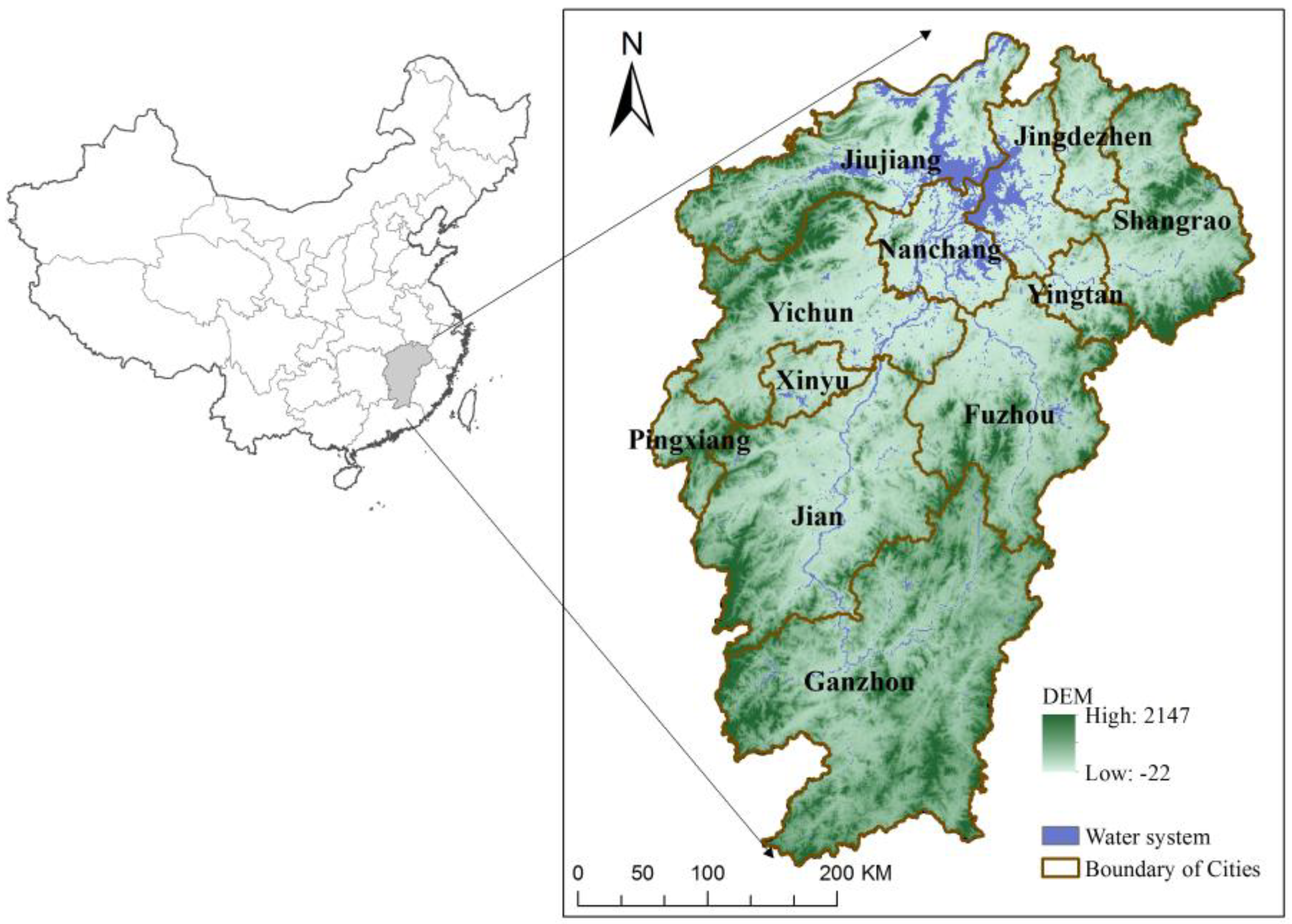
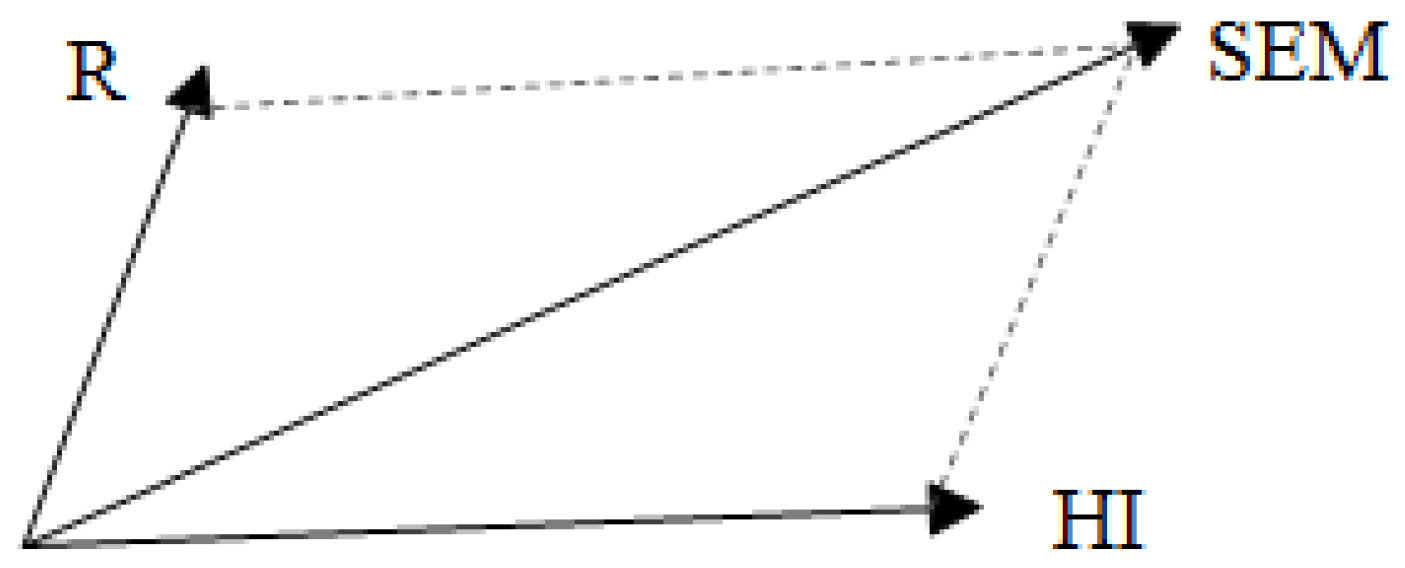
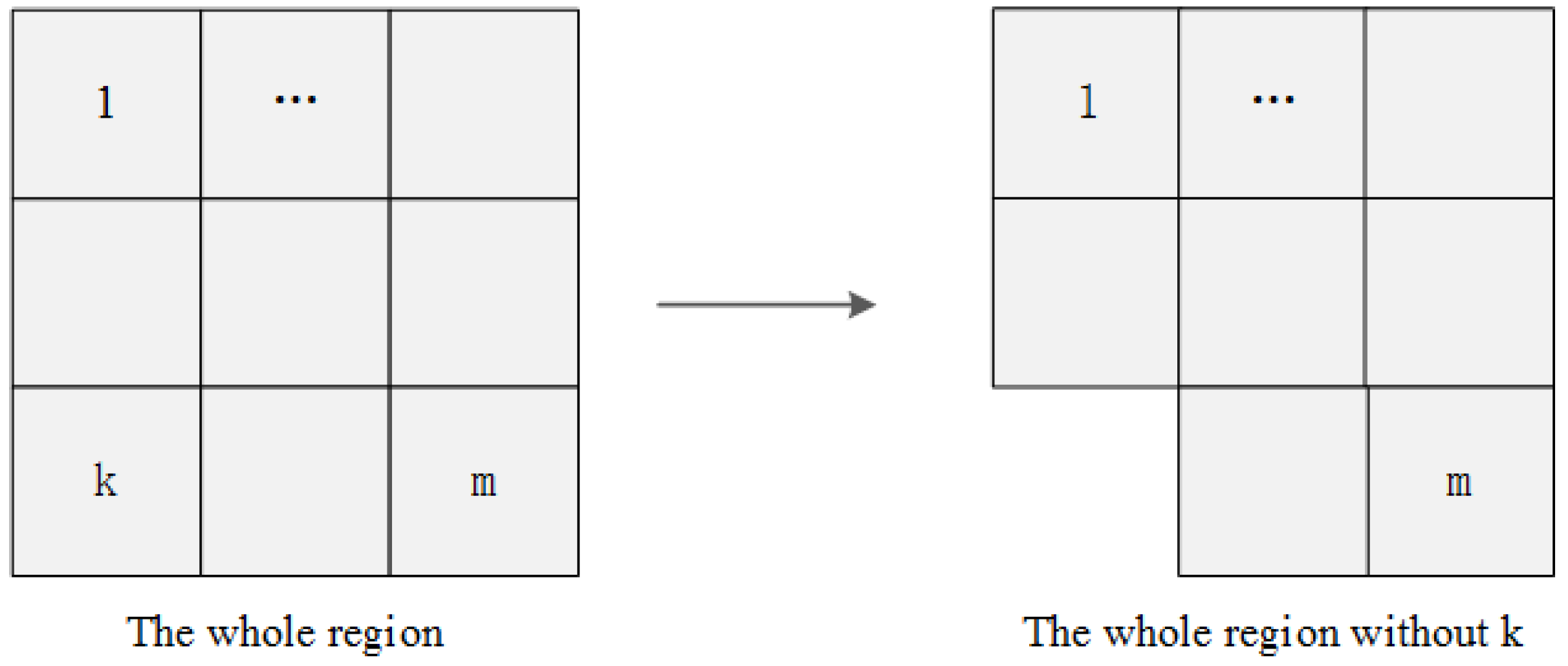
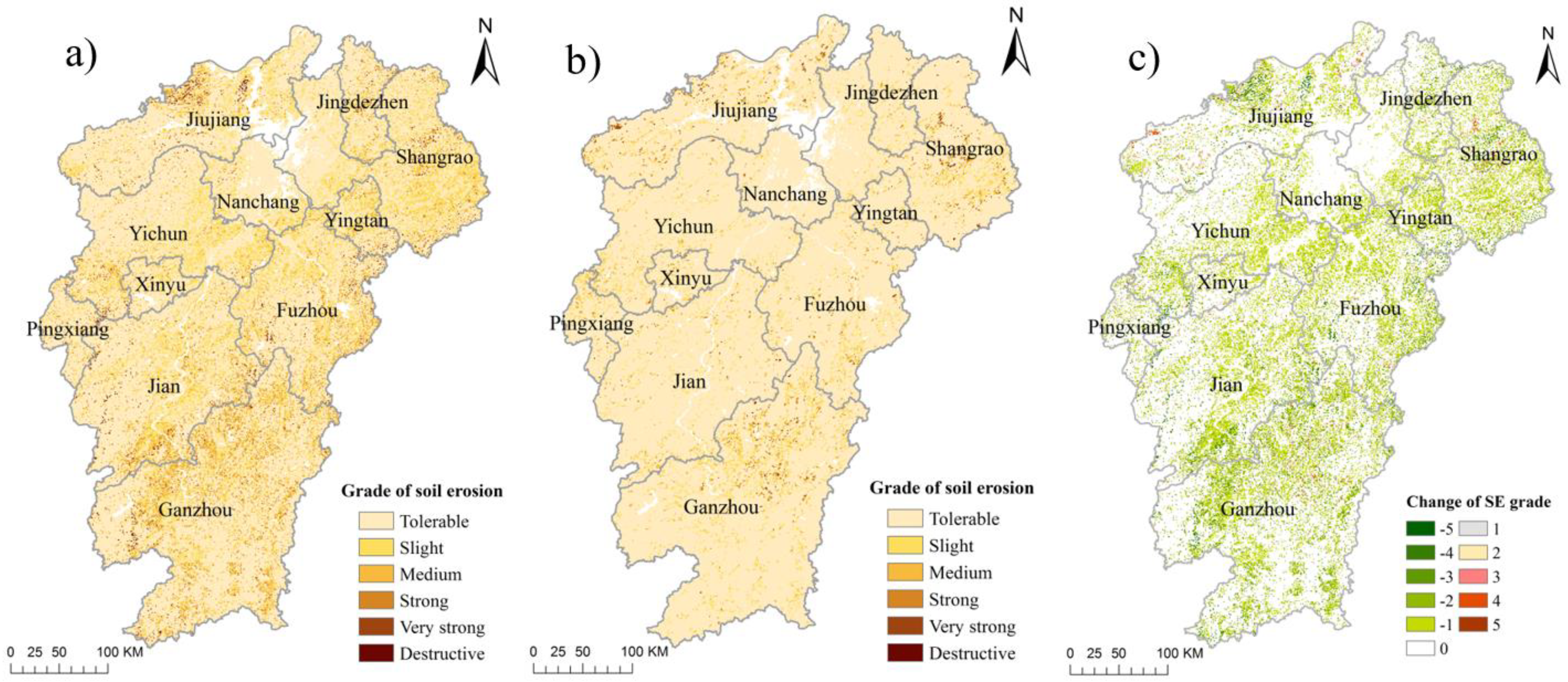
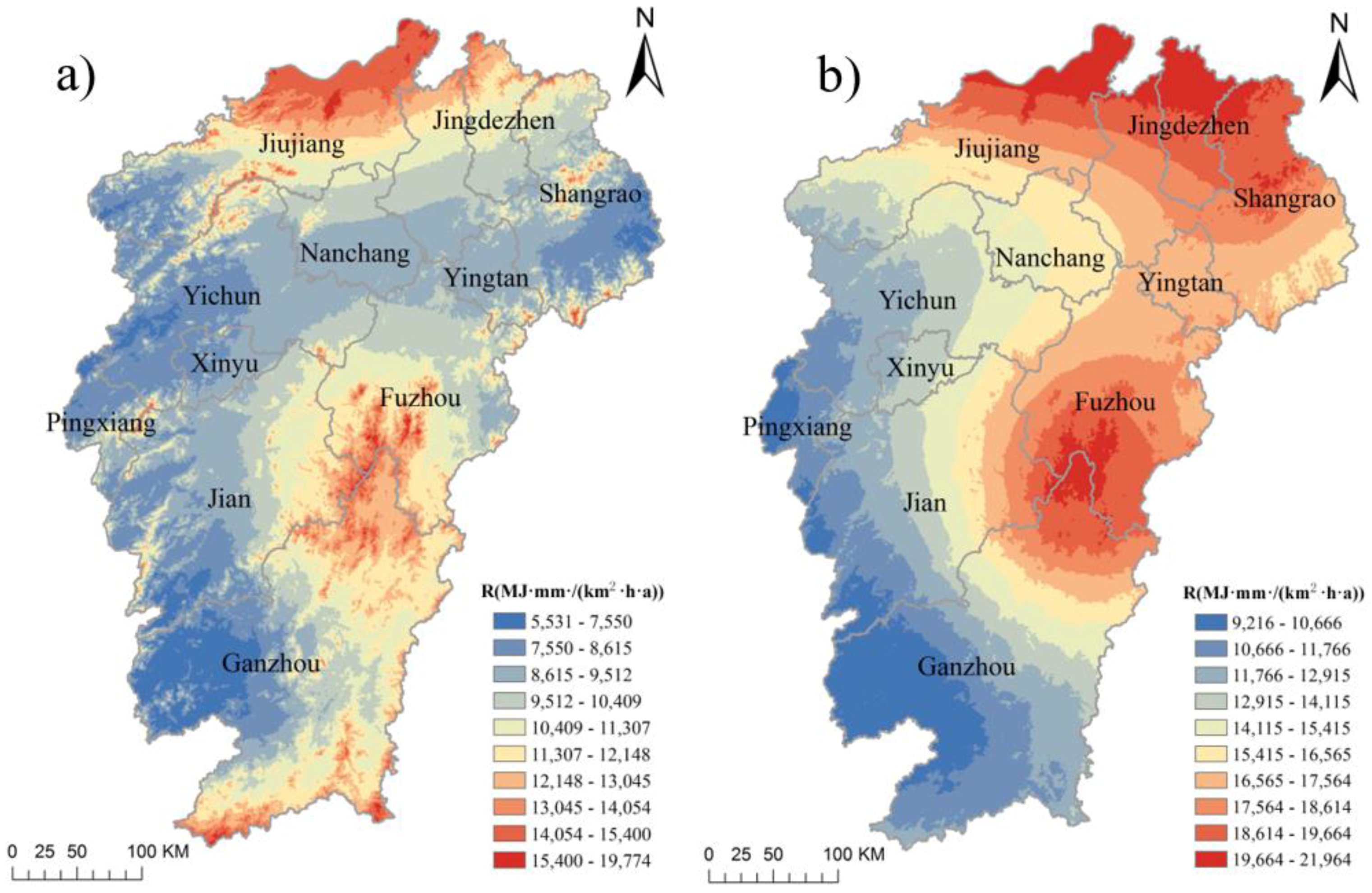
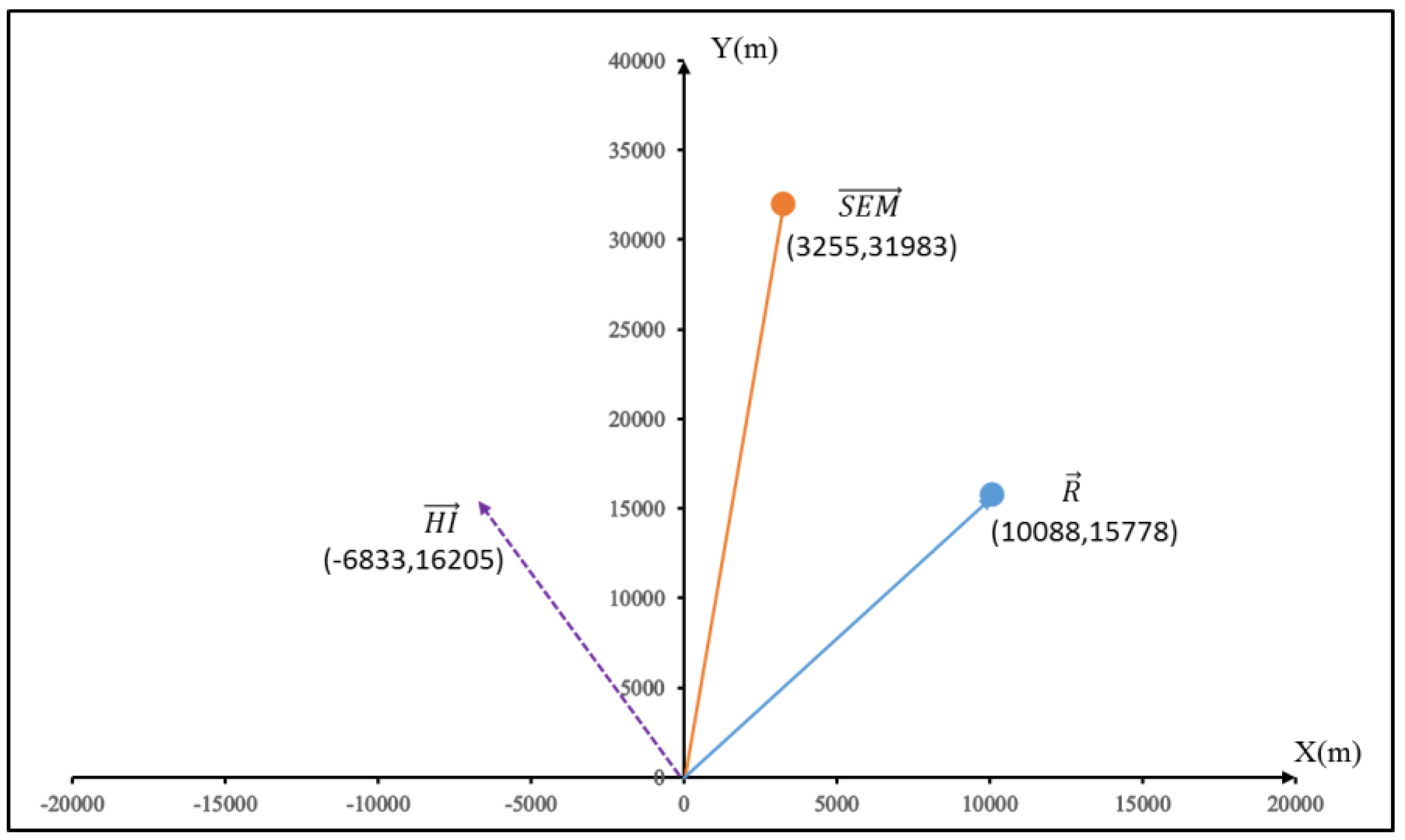

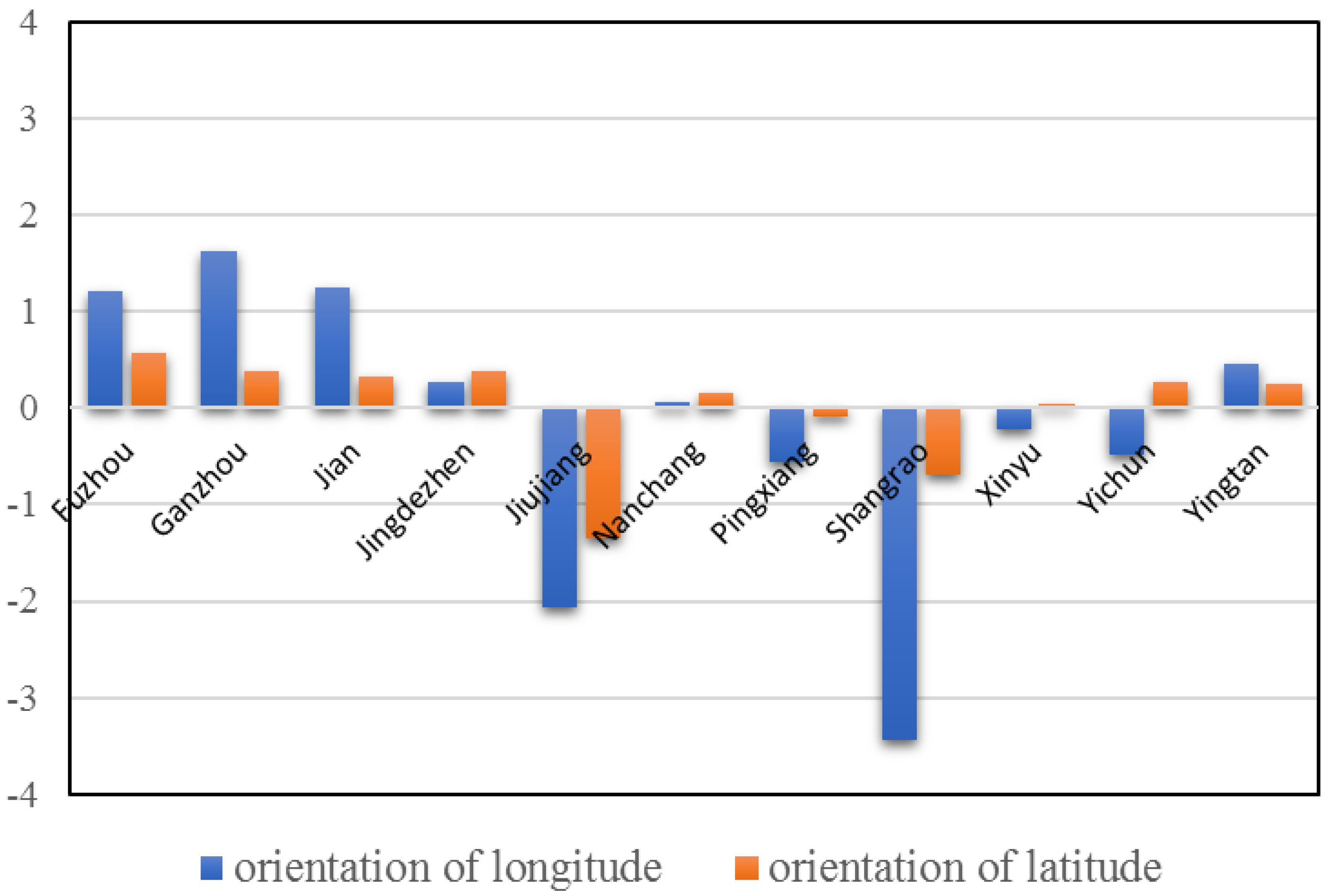
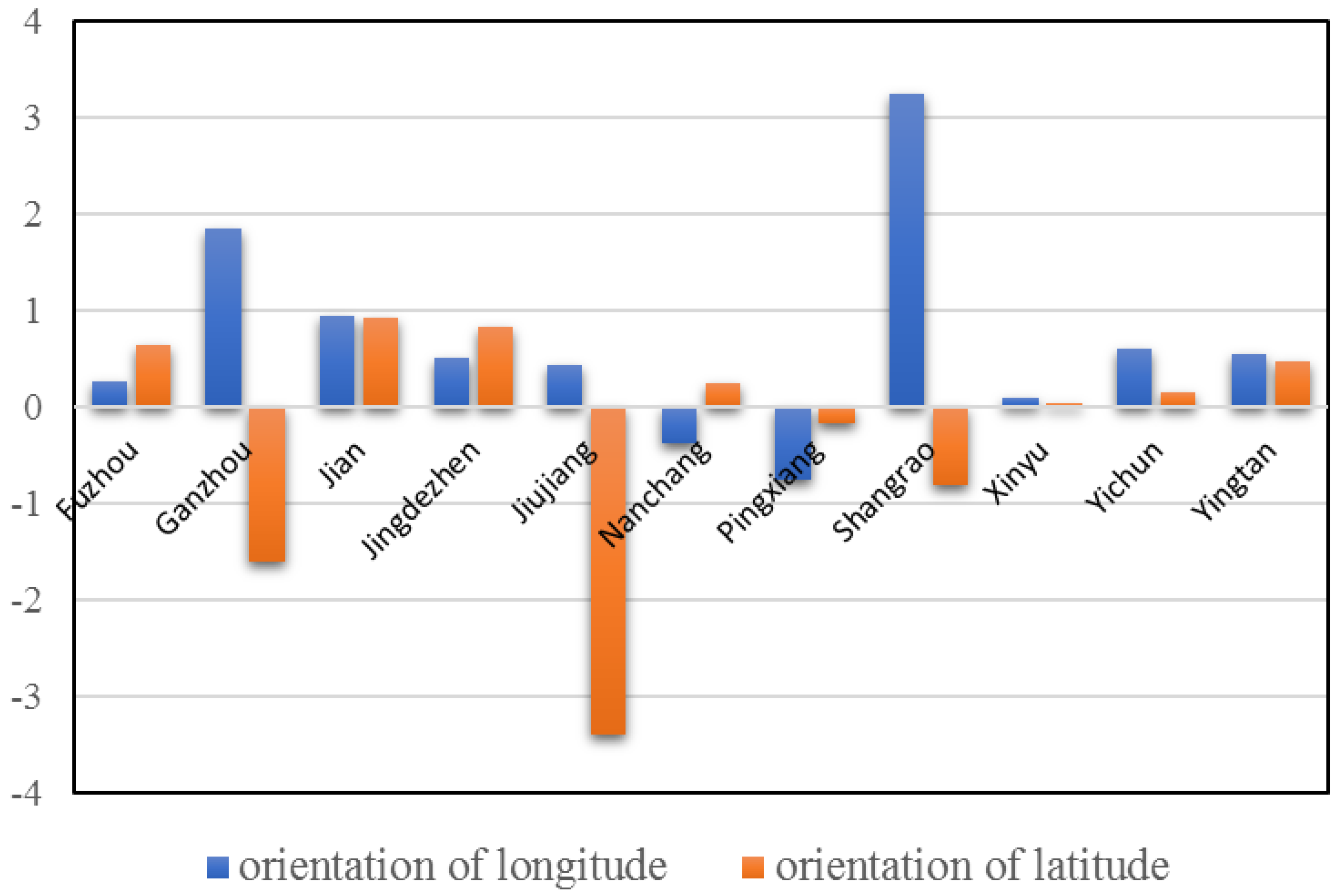
| Name | Data Type | Time | Scale/Resolution | Data Sources |
|---|---|---|---|---|
| Boundary of Jiangxi province and cities | SHP | 2010 | 1:4,000,000 | Resources and Environmental Scientific Data Center (RESDC), Chinese Academy of Sciences (CAS) |
| Boundary of watershed | SHP | 2008 | 1:4,000,000 | RESDC |
| Land use | grid | 1990/2015 | 1000 m | RESDC |
| DEM | grid | 2000 | 30 m | RESDC |
| Rainfall data | excel | 1990/2015 | / | RESDC |
| Soil database | SHP | 1990s | 1:1,000,000 | RESDC |
| Soil texture data | grid | 1990s | 1000 m | RESDC |
| Soil carbon pool | grid | 1980s–1990s | 1000 m | RESDC |
| NDVI | grid | 1990/2015 | 1000 m | RESDC |
| SEM(Mg/(km2·a)) | Grade | Grade Value |
|---|---|---|
| <500 | Tolerable | 1 |
| 500–2500 | Slight | 2 |
| 2500–5000 | Medium | 3 |
| 5000–8000 | Strong | 4 |
| 8000–15,000 | Very Strong | 5 |
| >15,000 | Destructive | 6 |
| City Name | 1990SEM_Mean (Mg/(km2·a)) | 2015SEM_Mean (Mg/(km2·a)) | Change (%) |
|---|---|---|---|
| Fuzhou | 1024.22 | 236.13 | −76.94 |
| Ganzhou | 1050.14 | 322.88 | −69.25 |
| Jian | 877.62 | 193.36 | −77.96 |
| Jingdezhen | 860.53 | 212.03 | −75.36 |
| Jiujiang | 790.06 | 439.97 | −44.31 |
| Nanchang | 370.11 | 85.85 | −76.80 |
| Pingxiang | 873.23 | 377.91 | −56.72 |
| Shangrao | 732.01 | 357.71 | −51.13 |
| Xinyu | 576.42 | 301.67 | −47.66 |
| Yichun | 589.14 | 204.95 | −65.21 |
| Yingtan | 1036.56 | 185.49 | −82.10 |
| Longitude | Latitude | |
|---|---|---|
| Rainfall impact | 3.1 | 0.49 |
| Human impact | −2.1 | 0.51 |
© 2019 by the authors. Licensee MDPI, Basel, Switzerland. This article is an open access article distributed under the terms and conditions of the Creative Commons Attribution (CC BY) license (http://creativecommons.org/licenses/by/4.0/).
Share and Cite
Huang, D.; Yang, X.; Cai, H.; Xiao, Z.; Han, D. Identifying Human-Induced Spatial Differences of Soil Erosion Change in a Hilly Red Soil Region of Southern China. Sustainability 2019, 11, 3103. https://doi.org/10.3390/su11113103
Huang D, Yang X, Cai H, Xiao Z, Han D. Identifying Human-Induced Spatial Differences of Soil Erosion Change in a Hilly Red Soil Region of Southern China. Sustainability. 2019; 11(11):3103. https://doi.org/10.3390/su11113103
Chicago/Turabian StyleHuang, Dong, Xiaohuan Yang, Hongyan Cai, Zuolin Xiao, and Dongrui Han. 2019. "Identifying Human-Induced Spatial Differences of Soil Erosion Change in a Hilly Red Soil Region of Southern China" Sustainability 11, no. 11: 3103. https://doi.org/10.3390/su11113103





